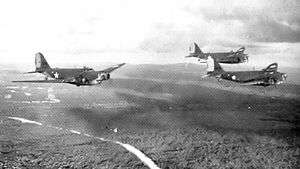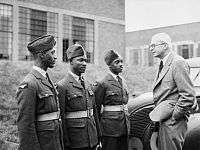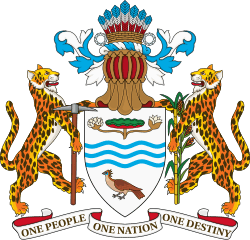British Guiana during World War II
The history of British Guiana during World War II begins in 1939, following the outbreak of war in Europe and the United Kingdom's declaration of war on Nazi Germany. Like all the other British colonies in the West Indies, Guiana gave full support to the Allied war effort by providing personnel for the British Armed Forces, land for an American military base, and raw materials for war production. Although the Guianese economy initially suffered as result of the war, large-scale infrastructural projects were undertaken, in order to optimize the production of goods for the war effort, and by the war's end in 1945 the Guianese economy had more than recovered. There were also significant changes in the country's political system during the same period, such as the legalization of political parties and the enfranchisement of women.[1][2]
| British Guiana during World War II | |
|---|---|
 American B-18 Bolos of the 12th Bombardment Squadron in flight over British Guiana in 1943. | |
| Location | British Guiana |
| Date | 1939–1945 |
| Events | The SS Caribia affair –March 1939 Declaration of war –September 3, 1939 Atkinson Field opened –June 20, 1941 The Blue Baron incident –June 1942 Victory in Europe Day –May 7, 1945 |
History
Economics
The outbreak of World War II put the economy of British Guiana into a state of decline, due to a decrease in trading activities, which initially led to a rise in unemployment. The war also resulted in a shortage of imported goods from Britain and North America, since many merchant ships were now being utilised for military transport. The effects of the shortage of imported goods were felt throughout the country. For example, there were no new bicycle tires or inner tubes, so owners of bicycles had to improvise by using discarded pieces of rubber to patch holes in existing tires. There was also a severe scarcity of flour and petrol for vehicles, and kerosene for domestic use was rationed. The government controlled the prices of goods, especially food items, and provided subsidies for necessary imports. However, the people quickly readjusted to the situation and there was no serious lack of food since Guianese farmers produced large quantities of food crops, including rice, cassava, plantains, sweet potatoes and eddoes, as well as vegetables.[1]
Despite the economic constraints caused by the war, infrastructural projects were carried out in various parts of the country. In 1940, for example, drainage and irrigation projects valued at $8 million began on the East and West Coasts of Demerara, in West Berbice, and on the Corentyne coast. Large-scale rice production by the government also began at Burma in the Mahaicony-Abary area. The use of farm machinery was introduced at this location, and work began on the building of a modern central rice mill.[1]
- Bauxite
British Guiana was a major supplier of high-grade bauxite to the United States during the war years. The aluminium produced from this bauxite was used by the American military for the production of aircraft. Significantly, roughly two-thirds of all Allied aircraft manufactured during the war years used aluminium made from Guianese bauxite. As a result of the demand for Guiana's bauxite, exports increased from 476,000 tons in 1939 to 1,902,000 tons in 1943. This enabled the Guianese economy to benefit greatly from the revenue obtained through these exports. The monetary worth of bauxite exports rose from approximately $2.9 million in the early 1940s to $6.7 million in 1947. This resulted from the developments in the Demerara Bauxite Company when it opened two mines at Mackenzie, thus creating more jobs in that sector for the Guianese people. At the end of the war, the Guianese Treasury had a surplus of more than $6 million, mainly due to the revenues earned by the bauxite industry.[1]
Military affairs

- Guianese military personnel
In Guiana, for the purpose of defence, the government organised two militia companies, a garrison, and a Voluntary Civil Defence Organisation. By the end of 1941, ninety-five Guianese had joined the British Armed Forces, of whom twenty-two were in the Royal Air Force and forty-two were in the Royal Navy. The remaining thirty-one were recruited for other specialised work. Scores of Guianese were also working in the merchant navy. In 1943, thirty-two Guianese enlisted in the British military, twenty travelled to the United Kingdom to serve as munitions workers in factories, and forty-eight joined the Trinidad Royal Navy Volunteer Reserve.[1]
The first batch of Guianese received training in Britain and some volunteered for British military service. Among them was E. R. Braithwaite, author of the classic To Sir, With Love, who served as an air crew member in the Royal Air Force. When the war ended in 1945, some Guianese in the military decided to return home, but many chose to remain in Britain.[1]
- Canadian Military Support
Six men were sent to Canada for training between 1942 and 1943, followed by five others in September 1943. In March 1942 there was concern that the ships carrying bauxite to Canadian aluminium plants might be sabotaged in the Demerara River. A local guard was established, and Canada sent No. 34 Company of the Veterans Guard of Canada to coordinate military security.[3]
- Atkinson Field
The United States at first remained neutral in the war but agreed in September 1940 to provide fifty old World War I-era destroyers to Britain. In return, Britain leased to the United States a number of sites stretching from Newfoundland in the north to Guiana in the south. These locations, which were to be used as American military bases, were leased for a period of ninety-nine years.[1]
Even before the United States entered the war in December 1941, the Americans commenced the building of an air base at Hyde Park on the east bank of the Demerara River, 40 kilometres (25 mi) south of Georgetown. The forest was cleared, hills were levelled, and a long concrete runway was constructed in 1941. The air base was soon named Atkinson Field, after the base commander Major Atkinson. Later in the year, the American 44th Reconnaissance Squadron was stationed there to protect the base, and to make regular air patrols between Panama and Guiana. Around the same time, a huge cigar-shaped American blimp passed along the coast of Guiana daily to keep a lookout for German U-boats.[1]
Shortly after opening, American aircraft began arriving at Atkinson with munitions and other goods, which were then ferried by other planes across the Atlantic Ocean to West Africa. From there the supplies were transported to North Africa for the British forces fighting against the Germans. War planes purchased by the British from the Americans were also ferried to North Africa through Atkinson Field.[1]
See also
References
- "111. GUYANA DURING THE SECOND WORLD WAR". Retrieved June 20, 2013.
- Sirvaitis, Karen (2009). Guayana in Pictures. Twenty-First Century Books. ISBN 1575059630.
- STACEY, C. P. (1955). "Official History of the Canadian Army in the Second World War- Volume I -Six Years of War" (PDF). National Defence and the Canadian Forces. Government of Canada. Retrieved July 31, 2016. p. 182
